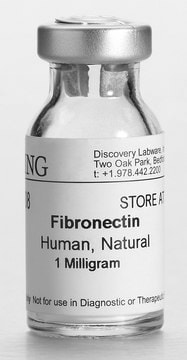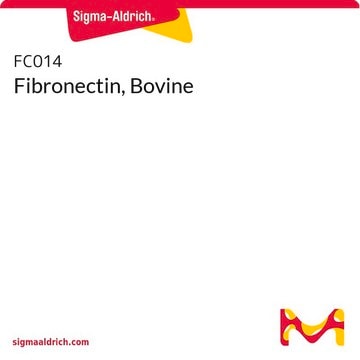F1056
Human Fibronectin
from human plasma, powder, suitable for cell culture
Sinonimo/i:
Fibronectin
About This Item
Prodotti consigliati
product name
Fibronectina, lyophilized powder, BioReagent, suitable for cell culture, ≥95% (SDS-PAGE)
Origine biologica
human plasma
Livello qualitativo
Sterilità
sterile
Nome Commerciale
BioReagent
Saggio
≥95% (SDS-PAGE)
Forma fisica
lyophilized powder
Confezionamento
pkg of 1 mg
pkg of 2 mg
pkg of 5 mg
tecniche
cell culture | mammalian: suitable
Copertura della superficie
1‑5 μg/cm2
Solubilità
H2O: 1 mg/mL at 37 °C
N° accesso UniProt
Specificità del legame
Peptide Source: Collagen
Condizioni di spedizione
dry ice
Temperatura di conservazione
−20°C
Informazioni sul gene
human ... FN1(2335)
Cerchi prodotti simili? Visita Guida al confronto tra prodotti
Descrizione generale
Applicazioni
- in neural selection medium to coat tissue culture surface for neuronal differentiation
- to coat culture vessels for characterization of iPSC and iPSC‑derived BMEC in 2D cell culture
- to coat culture supports for endothelial cell culture
Azioni biochim/fisiol
Avvertenza
Nota sulla preparazione
In coating culture surfaces, fibronectin should be diluted in sterile balanced sterile salt solution and coated with minimal volume. Surface should then be air dried for 45 minutes at room temp and can be stored for 2-4 weeks at 2-8°C.
Esclusione di responsabilità
Codice della classe di stoccaggio
11 - Combustible Solids
Classe di pericolosità dell'acqua (WGK)
WGK 3
Punto d’infiammabilità (°F)
Not applicable
Punto d’infiammabilità (°C)
Not applicable
Dispositivi di protezione individuale
Eyeshields, Gloves, type N95 (US)
Certificati d'analisi (COA)
Cerca il Certificati d'analisi (COA) digitando il numero di lotto/batch corrispondente. I numeri di lotto o di batch sono stampati sull'etichetta dei prodotti dopo la parola ‘Lotto’ o ‘Batch’.
Possiedi già questo prodotto?
I documenti relativi ai prodotti acquistati recentemente sono disponibili nell’Archivio dei documenti.
I clienti hanno visto anche
Articoli
Extracellular matrix proteins such as laminin, collagen, and fibronectin can be used as cell attachment substrates in cell culture.
Protocolli
Dilute fibronectin for cell attachment, varying per cell type. Coating protocol, products, and FAQs provided.
Il team dei nostri ricercatori vanta grande esperienza in tutte le aree della ricerca quali Life Science, scienza dei materiali, sintesi chimica, cromatografia, discipline analitiche, ecc..
Contatta l'Assistenza Tecnica.






